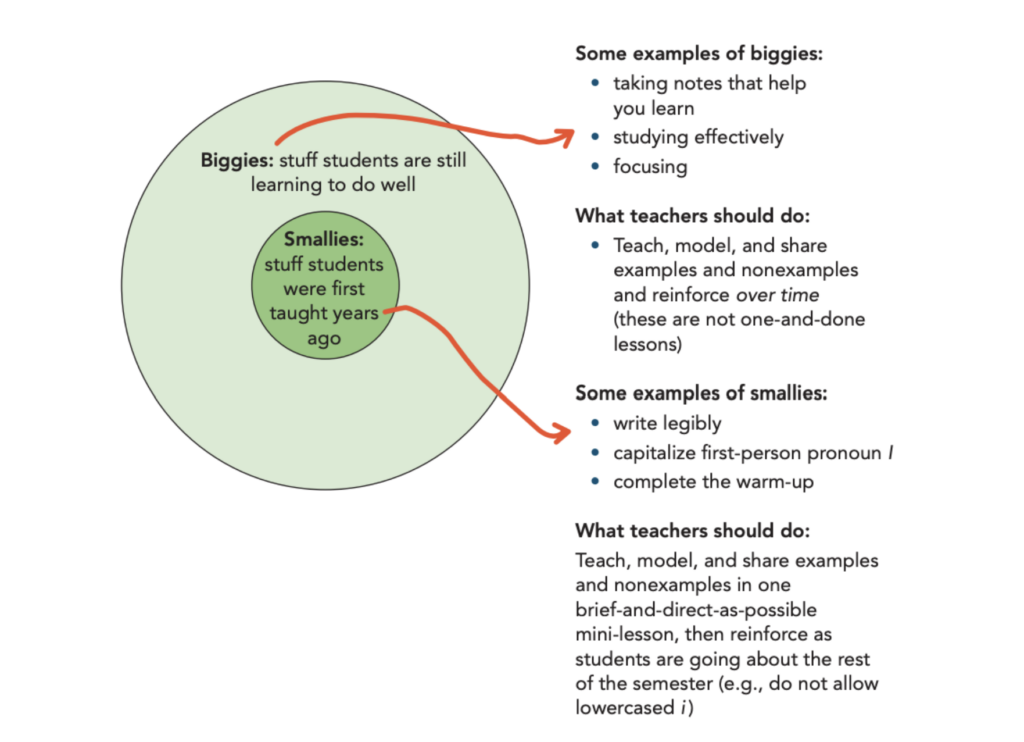To me, the most powerful thing you can do to improve student effort is teach them, very clearly and well, what good effort looks like. And to really get the Effort belief zinging, you ought to do this not just for some things, but for all things…at least, all the things that you expect your students to do.
In my book, I call this kind of explicit instruction “Woodenization,” after the famed UCLA basketball coach teacher who made sure each new season to teach his players to put on their socks and shoes.
The thing with Woodenizing learning behaviors, though, is that there are really two tiers of behaviors: Smallies and Biggies.

Screenshot from Strategy 7 of The Will to Learn (2023)
Smallies are things that you can reasonably expect your students to comprehend within five minutes or so of direct instruction. Typically, then, these are things they've been taught many times before.
Smallies
In my classroom, Smallies are things like:
- How to enter the room
- How to begin the warm-up at the bell
- How to capitalize proper nouns
- How to set up a page of notes
All of these are things that ninth graders can be taught a single time and then expected to do.
HOWEVER, the key with smallies isn't the five-minute mini-lesson — it's consistent reinforcement.
Going back to John Wooden, I am sure that a time came each basketball season when a player would be on the court and his shoe would come untied. This is the critical (and inevitable) moment with the Smallie. In this situation, it's not that the student doesn't know how to tie his shoes like John Wooden taught him to. It's that the player forgot, or the player was distracted, or the player was in a hurry.
And so, what's a teacher to do?
This is what I imagine John Wooden did:
- Pull the player aside.
- Ask him why his shoe came untied.
- Remind him of the proper technique and why it's important.
- Ask him if he needs anything to help him be successful in this area moving forward.
No shame. No belittling.
But also no letting it slide. No, “Oh, it's okay, stuff happens.”
Smallies live or die by reinforcement.
Biggies
Biggies, on the other hand, are behaviors that you'll need to teach (through modeling, examples, non-examples, etc.) many times in order for your students to grow to understand them. In Wooden's case, this was probably stuff like passing the ball, shooting the three, or setting the defense. Whereas Smallies are mostly matters of habit, Biggies are mostly matters of skill.
And so Biggies, of course, must be taught many, many times. They need to be practiced. Students will need lots of feedback.
- For a good example of what a Biggie progression looks like in my classroom, check out this article on how I teach note-taking.
For the sake of today's article not becoming a book, I'll close my remarks there. The point is just this: when you're teaching a learning-conducive behavior, be mindful of what kind of behavior it is.
Is it a Smallie? Or a Biggie?
That will help you avoid wasting your time and theirs.
Best,
DSJR
Toni Rivera Ramos says
Hello! I’m not getting your newsletters, even though I’ve signed up twice!
davestuartjr says
Toni, this is not good! I wonder if it is getting caught in spam or in your email provider’s “marketing / promotions” tab. Have you checked those?